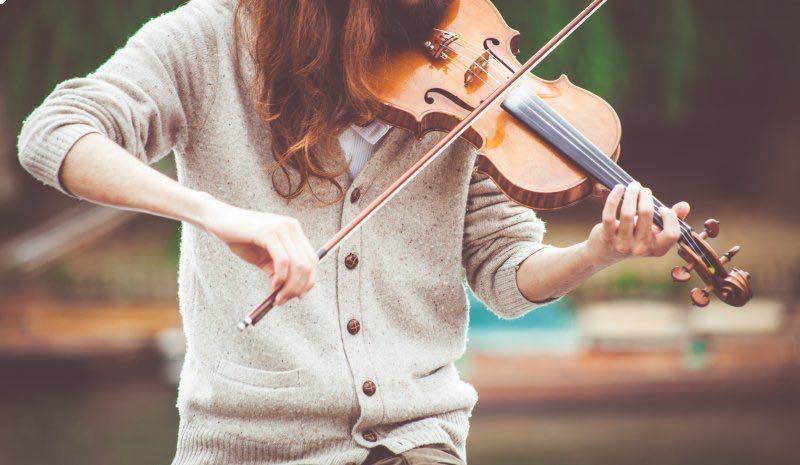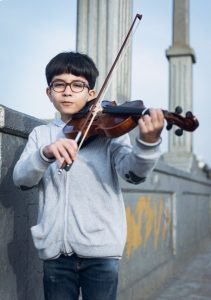There are many different types of violin, and the instrument has evolved over the centuries for a number of reasons.
First of all, violins come in a variety of sizes. As a young child, I started on a tiny, 1/8th size violin. However, I quickly progressed to a full size. For children beginning their musical journey, it’s important to start with an appropriately sized violin. And of course, guidance from an experienced instructor is essential.
Renting a violin can be a great option for new students. This provides some flexibility until the student shows a keen interest and a desire to progress.
The Evolution of the Violin
The violin really came into being during the Baroque period, around the 17th century. There were instruments similar to the violin prior to this, such as the viol or three-stringed violetta. However, the technique for playing these instruments is somewhat different to the violin as we know it today. The Baroque violin has a slightly different shape. But the most noticeable difference is in the tuning.
Baroque violins are typically tuned to an A at 415 Hz or Hertz. Today, we are more accustomed to A being 440 Hz.
J.S. Bach was one of the most prominent composers of this period. He lived in Germany from 1685-1750. His collection of Sonatas and Partitas for solo violin are a must-have for any violinist.
Evolution of the Classical Violin
The classical violin as we know it today was developed in the 18th century. This violin was developed with great violin makers like Guarneri and Stradivarius.
Antonio Stradivarius lived from circa 1644 until 1737. His finest violins are considered to be those built between 1700-1720, known as his Golden Period. I had the pleasure of playing one such violin, The Windsor-Weinstein Strad made in 1717. This is a wonderful instrument with a glorious tone quality.
Another intriguing Strad is The Red Mendelssohn. This violin was made in 1720, and is now owned by the internationally famous concert violinist, Elizabeth Pitcairn. I had the pleasure of working with Elizabeth recently, and was able to experience the quality of the violin at close quarters.
The Red Mendelssohn was also the inspiration for a film called, The Red Violin. The film starred Samuel L. Jackson, with music composed by John Corigliano and played by Joshua Bell. I was very fortunate to be asked to take part in these recording sessions in London back in 1998.
Different Types of Violin for Different Genres
Of course, different genres require different types of violin. The electric violin is very popular with rock musicians such as Mik Kominski in the Electric Light Orchestra or ELO.
These types of violin have no sound post or f-holes to produce their sound. Instead, the sound is produced electronically through an amplification process. Acoustic violins can be fitted with a pick-up. This way, their sound can be amplified while still retaining an acoustic quality. This was the type of violin played by Charlie Daniels in The Devil Went Down To Georgia.
Another interesting type of violin is the Stroh violin. It was invented by John Stroh in 1899 and was very popular in the early 20th century particularly in small theatres and music-halls. In the 1920s it could also be heard in Argentinian tango orchestras being played by the likes of renowned violinist and director Julio de Caro.
What’s the Difference Between a Violin & A Fiddle?
I am often asked the question “What is the difference between a violin and a fiddle?”. Truthfully, there is no difference in the actual instrument. In fact, having spent many decades playing in symphony orchestras, I often refer to my violin as a fiddle.
That said, the term “fiddle” is more commonly used when playing folk music or music from countries like Ireland or Scotland. Here in the USA, fiddling styles like bluegrass and Texas swing are popular.
In Norway, they have a particular type of violin known as a Hardanger fiddle. This is somewhat similar to the classical violin, but can have as many as 8 or 9 strings rather than the 4 that we use.
5 String Violin
Finally, let’s look at the seldom used 5 string violin. The fifth string is a low C below the G at the bottom. This gives the instrument a range encompassing both violin and viola.
Those of us accustomed to the regular 4 string violin have to be careful with string crossing as the angle between the strings is a little smaller. However, it does make playing double and triple stops (two or three notes at the same time) much easier.
Choosing the Right Type of Violin for Yourself
There are many types of violins. Choosing the right one for yourself will be determined by a number of factors. The size of the violin is most important. This is especially true for a young child. A violin that is too big could lead to problems with the neck, shoulder, and arms. If in doubt, err on the side of too small. Most importantly, never let a child try to “grow into” a larger violin.
Renting or Buying a Violin
You also need to decide whether to rent or buy. It’s often a good idea to rent for a while. This is especially true if the child is very young and still growing. Check with a local violin shop for their prices and policies. They should include a bow and a case, but do they also include accessories like rosin?
The quality of sound is very important. However, you may not want to spend a huge amount of money in the early days. Buying a good beginner violin can cost several hundred dollars. You will get better quality by increasing your budget, but not many can afford the millions required for a Strad!
Try Lots of Different Violins Before Choosing
Be sure to try many different types of violin before making a decision. Every violin has its own unique sound, so be sure you are happy with the sound you make. Have someone else play it for you. Hearing a professional violinist can help you hear the accurate sound of your instrument.
Most Importantly, Have Fun!
Most importantly, remember that playing the violin should be fun. Even better, learning violin can lead to a rewarding career. I have been lucky to have had the opportunity to perform in every major concert hall in the world. And I will do all I can to share my knowledge and experiences, so you, too can enjoy the rewards of playing the violin.
Good luck to you all.
Steve Merson


